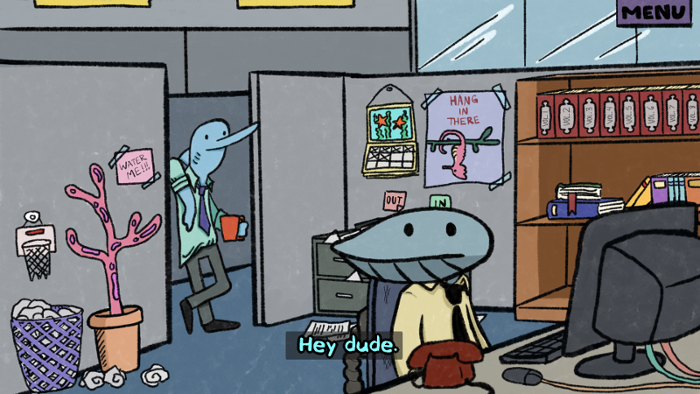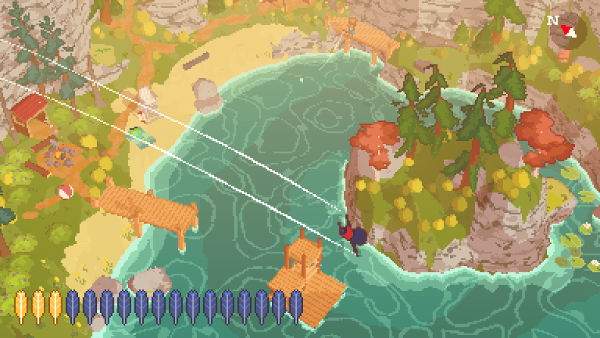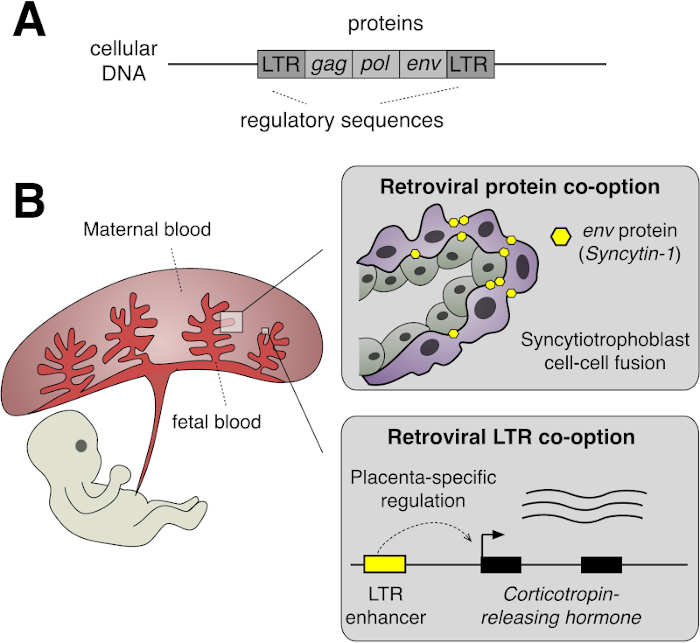Latest reviews
I’m a big fan of point and click adventures (think The Secret of Monkey Island), a genre that’s frequently been declared dead but that is in fact thriving thanks to crowdfunded major efforts like Broken Age (reviews) and Thimbleweed Park (reviews), smaller studios like Wadjet Eye, and releases by even smaller teams or solo developers. Clam Man is very much the latter, developed by “Team Clam” which appears to comprise three collaborators.
The game is set in a world dominated by anthropomorphic aquatic creatures. You play Clam Man, an ordinary bloke working as a junior sales representative at Snacky Bay Prime Mayonnaise. After Clam Man gets fired for no apparent reason by his crab boss, he begins to uncover a larger mayo-centered conspiracy. Does it go all the way to the top? Mr. Man will try to find out.

Not all is as it seems at Snacky Bay Prime Mayonnaise. (Credit: Team Clam. Fair use.)
It’s all ridiculous, of course, but some of the jokes are quite funny, and the minimalist hand-drawn art is often very charming. This is only a two hour game, the mouse controls are a bit frustrating, and the writing and artwork don’t quite hold up throughout the short playtime, so the current asking price of $10 is a bit high.
If you already own the game from The Mother of All Bundles, or if you can get it for $5 or less, you’re unlikely to regret your visit to Snacky Bay. Team Clam is certainly one indie developer to keep an eye on.
Der Campingplatz lädt durch eine vielzahl positiver Eigenschaften zum längeren Verweilen ein.
Auch der Aufenthalt auf den angenehm gelegenen Übernachtungsstellplätzen ist sicherlich lohnenswert.
Der Aufbau des Platzes ist terassenförmig. Es gibt Komfort(stell)plätze mit ausreichend Platz um nicht mit den Nachbarn Tür an Tür zu sitzen.
Das Restaurant am Platz bietet eine angenehme Auswahl an gut bürgerlichen Gerichten, die gut umgesetzt sind und ebenso schmecken.
Für Kinder gibt es einige Angebote, täglich wechselnd, wie z.b. Ponyreiten oder auch eine kleine “Wanderung” mit Fackeln.
Wir waren mit unserem einjährigen Kind im Wohnmobil an einem Komfortstellplatz.
Zu unserem Bedauern wurde das Plantschbecken entgegen anderer Aussage, nicht in Betrieb genommen. So konnten wir mit unserem Kind nur ins Schwimmbecken was natürlich nicht denselben Spaß bedeutet. Zum Abkühlen hat es gereicht.
Der Kiosk hat zwar feste Öffnungszeiten, diese werden jedoch nicht (immer) eingehalten. An einem heißen Sonntag mussten wir zwei Stunden länger warten um etwas trinkbares zu bekommen.
Gestört haben uns die späten Ruhezeiten, ab 23 Uhr, die das ein oder andere Mal durch Nachbarn genutzt wurden, sowie das ein Dauercamper uns mit seinem tollen Pizzaoffen einen Nachmittag und Abend lang eingeräuchert hat, da dieser mit offenem Feuer betrieben wird. Unser Kind wurde während des Mittags und abendlichen Schlafs entsprechend eingeräuchert, da es zu warm war um die Fenster im Wohmobil geschlossen zu lassen.
Der Platz ist aus unserer Sicht gut geeignet für “Übernachtungsgäste” und Personen mit älteren Kindern oder ohne Kinder, die keine Ruhe brauchen.
Im Jahr 2061 droht die Sonne zu einem roten Riesen zu werden. In 100 Jahren wird es die Erde nicht mehr geben und in 300 Jahren wird das Sonnensystem nicht mehr da sein. Es gibt eine Erdregierung, die beschliesst die Erde mit Raketen in das 4.2 Lichtjahre entferne Alpha Centauri Sternensystem zu bringen.
A depiciton of scenes with minimalist graphics and some objects in places/situations that are out of the ordinary. The only interaction happens at pauses where you are forced to click flashing objects to move to the next segment.
I made it through 3 uninspiring scenes before tapping out. I found the style interesting, but it didn’t go anywhere. The scenes aren’t pretty enough to be appreciated solely for beauty and I found no insight in the places forms were changed from the ordinary.
A Short Hike lets you explore the colorful, pixelated world of Hawk Peak Provincial Park in the role of a vacationing anthropomorphic bird named Claire. Your mission, should you choose to accept it, is to make it to the top of Hawk Peak, ostensibly in search of cell phone reception.
As you make your way through the park, you meet a diverse cast of animal characters. Some offer you side quests, others are simply pursuing their own adventures in the park. It’s up to you whether you want to accept any of these quests, but if you want to make it to the peak, you’ll need to at least obtain a few golden feathers, which allow you to climb the distance.
The game doesn’t end after you reach the peak. There are treasures to be found, hats to be purchased, fish to be caught, and co-operative games of beachstickball to be played. And it’s fun to explore. In spite of the intentionally low resolution graphics, when you sky-dive from the top of a hill, A Short Hike manages to convey a real sense of velocity and freedom.

You can fly, dive, swim, climb, walk, and run. (Credit: Adam Robinson-Yu. Fair use.)
You can’t die in this world, or screw up in any irreversible way. Nor does the game offer the endless grind of more complex farming, fishing, and crafting games. You can rush through the game, or spend a few hours with it, but after that, you’ll likely be done with it—at least until you feel like paying another visit to the park.
If you’re looking for a game to challenge your reflexes or your logic, this ain’t it. But if you just want to chill in a beautiful setting, it’s a perfect pick-me-up.
Sapiens: A Brief History of Humankind tries to present the entire Homo Sapiens existence in a single book, through the analysis of three fundamental revolutions that witnessed humankind as the protagonist: the Cognitive revolution, the Agricultural revolution and the Scientific revolution.
Keeping this simple chronological structure, the author provides challenging ideas and presents historical fact in a way that I haven’t personally seen before.
I found the book well written and thought provoking. Most of the time the author doesn’t provide a single view on a topic but presents different angles and interpretations explaining their pros and cons. This often led me to argue by myself for one or the other view and comparing my observations to the ones provided by the author.
Throughout the book you can hear loud and clear what is probably one of the obsessions of the author. Most of the topics presented are filtered through the question “Did this improve the happiness of humankind? What about the happiness of the individual?”. This, as far as I know, is a reading that is seldom presented in schools or by other historians and gives a whole different perspective on history. You will find yourself challenged by claims that might have never occurred to you and might make you uncomfortable. You will be asked to rethink or solidify your positions on sex and gender, twentieth century ideologies, religion, racism, slavery, equality, animal rights, morals and ethics, individualism, nationalism and consumerism.
The author saves the last couple of chapters for what they probably consider the most important questions to ask ourselves. Are you happy? Are you entitled to decide of your own happiness? What is happiness? Is it equivalent to pleasure? Can we reverse engineer happiness? And again, can we hack evolution and take control of it, decide where to go next? Can we achieve supernatural abilities, enhance ourselves or are we doomed to go the way of Dr. Frankenstein? What are the ethical implications of all this? Can we even imagine a future in which Homo Sapiens is not a “God on earth”, in which it’s not the dominant species?
At times the author makes little effort to hide their personal beliefs. From reading the book I would assume the author is vegan (or at least supports the animal rights movement) and a Buddhist (especially interested in the peculiar Buddhist idea of happiness). This is not necessarily a negative but occasionally alters the impartiality of the author in analyzing a topic.
The last chapter also provides a series of “predictions” about the future of humans and technology. While this is done to lead the reader to more philosophical questions, these are still predictions of a 2014 (non necessarily tech-savvy) person. This felt like reading a novel from the Fifties talking about the technology of the future. A few of them have a sci-fi taste and in other cases are simply outdated (especially when it comes to AI and superintelligence). This is not necessarily the author’s fault and actually confirms the fact that scientific research is advancing faster than the average Homo Sapiens can manage to process.
I would suggest it to anyone who is looking for a non-fiction book than can help you rethink yourself as a person and ourselves as a species.
In Some Assembly Required, biologist Neil Shubin explores a theme he already touched upon in his 2008 book Your Inner Fish and the 2014 PBS documentary of the same name: How do complex bodies, with all their specialized functions, evolve? How does evolution build on that which has come before?
To answer these questions, Shubin revisits the discoveries of biologists and naturalists of the past and introduces some of the most recent findings of molecular biology. This is a popular science book, so scientific facts become stories whose protagonists are brought to life with biographical detail.
The key concepts Shubin introduces include:
-
how biological traits that have evolved for one function are re-purposed (exapted) for another (e.g., feathers likely evolved first for temperature regulation, then were exapted for flight);
-
how small changes in embryonic development can have dramatic effects on the resulting individual—e.g., the slowing of physiological development known as neoteny, where adults may retain traits otherwise only seen in the young;
-
how gene duplication events (e.g., via self-copying genes known as transposons or “jumping genes”) enable evolution to experiment with myriad small variations of existing genetic recipes, which has led to vast gene and protein families;
-
how plant and animal cells incorporated previously free-living organisms and thereby gained crucial new capabilities, the classic examples being mitochondria (the powerhouses of animal cells) and chloroplasts (the photosynthesis engines of plant cells);
-
how viral elements have made their way into our DNA and have been co-opted for important biological functions (e.g., to make the protein syncytin, which is a key component of the placental barrier between fetus and mother).
Shubin explains how evolution often arrives at the same solution multiple times, with different genetic origins, and illuminates why some evolutionary pathways are likelier than others.

A retrovirus upon integration in the host genome (A), where its genetic code has been co-opted for building a protein used in placental development (B, top), and for the regulation of birth timing (B, bottom). (Credit: PLOS Biology / Edward B. Chuong. License: CC-BY.)
The book only scratches the surface of these concepts, and much of what it does cover is likely to be well-trodden ground for readers who have picked up a book about evolutionary biology since their school days. At the end of each chapter, I found myself hungry for more detail.
To Shubin’s credit, in the final section of the book, he provides a kind of afterword for each chapter, which includes sources and additional reading recommendations. I found this approach much more useful than a conventional bibliography or a set of disjointed footnotes.
I would give this book 4 stars — it’s a light, quick and engaging read on a fascinating topic. For readers looking for more breadth or more depth, I would recommend the following writers:
-
Richard Dawkins, if you are not put off by his politics, is still one of the best science writers I know. The Greatest Show on Earth: The Evidence for Evolution (2009; reviews) is a passionate, detailed and eloquent introduction to evolutionary biology.
-
Nessa Carey has a remarkable talent for getting as close to the science as possible while still writing for a lay audience. I read The Epigenetics Revolution (2012) and was deeply impressed by her clarity and ability to break down very complex concepts.
-
Andreas Wagner is a biologist bringing his own ideas to a larger audience through popular science writing. If the science behind it withstands scrutiny, Arrival of the Fittest (2014; reviews) could well be turned into a new chapter in the next edition of Some Assembly Required.
In short, Wagner argues that in order to find new functions for old genes, evolution has to take a “genetic walk” from A (old function) to B (new function). He explains the importance of neutral mutations in these genetic walks. His latest book, Life Finds a Way: What Evolution Teaches Us About Creativity, looks similarly fascinating.
If you’re on the fence about Some Assembly Required, consider getting a copy of the PBS documentary Your Inner Fish. It showcases Shubin’s storytelling talent while still packing a good amount of science. If you enjoy it, you’re unlikely to be disappointed by Some Assembly Required.
A Normal Lost Phone (reviews) by Accidental Queens allowed the player to explore a simulated smartphone to discover what happened to its owner, an 18-year-old named Sam. Another Lost Phone uses the same idea to explore different themes. This time, the phone in question belongs to a woman named Laura, who has apparently gone missing.
SMS messages reveal that her boyfriend, Ben, is deeply concerned about her disappearance—but some of his earlier messages suggest a controlling personality, hinting at another story to be uncovered.
The story is told through messages, photos, emails, calendar entries, and notes, many of which are only accessible until you’ve figured out a password or PIN number through various clues. Most of these puzzles are pretty easy, but if you find yourself getting stuck, the excellent Steam Guide will help you to advance without any spoilers.

The first messages we see are from Laura’s boyfriend Ben, expressing deep concern about her disappearance. (Credit: Accidental Queens. Fair use.)
Like the first game, Another Lost Phone explores sensitive social topics with appropriate care, if you can get past the inherently voyeuristic storytelling device of exploring a stranger’s phone.
The game feels a bit more polished than A Normal Lost Phone, with a more engaging story, where all the different pieces (messages and clues) click together really well. Each game tells its own independent story, and if you’re unsure which one to try first, I recommend this one. My playtime was about 1-2 hours.
“The Road To Forgiveness” - By: Bill and Cindy Griffiths is a powerful true story of a couple who forgave the woman who hit and killed their daughter and mother / mother-in-law while driving drunk. It’s one of the best books I have ever read. If you are interested in powerful, true stories you should love this book.
What’s not to love? I can’t go wrong with classic hymns and my favorite singer. I absolutely love it! There are a lot of great voices in music, but none of them touch my heart more than Lauren’s voice does. I only wish there were more songs. Lauren explained that she didn’t want to put too many songs on this release because she didn’t want the majority of them to be overlooked. She wanted more attention to be paid to each individual song that’s on the release. I can understand this reasoning but I still wish there were more songs. Only 6 songs here, but a great EP by Lauren Talley.
